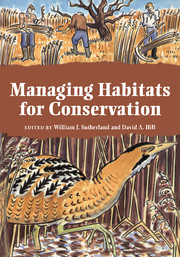Book contents
- Frontmatter
- Contents
- List of Contributors
- Acknowledgements
- 1 Introduction and principles of ecological management
- 2 Site management planning
- 3 Access
- 4 Coastal habitats
- 5 Rivers, canals and dykes
- 6 Waterbodies
- 7 Reedbeds, fens and acid bogs
- 8 Grasslands
- 9 Farmland
- 10 Lowland heathland
- 11 Upland moors and heaths
- 12 Woodland and scrub
- 13 Urban areas
- Some useful addresses
- Index of species by common names
- Subject index
2 - Site management planning
Published online by Cambridge University Press: 05 February 2015
- Frontmatter
- Contents
- List of Contributors
- Acknowledgements
- 1 Introduction and principles of ecological management
- 2 Site management planning
- 3 Access
- 4 Coastal habitats
- 5 Rivers, canals and dykes
- 6 Waterbodies
- 7 Reedbeds, fens and acid bogs
- 8 Grasslands
- 9 Farmland
- 10 Lowland heathland
- 11 Upland moors and heaths
- 12 Woodland and scrub
- 13 Urban areas
- Some useful addresses
- Index of species by common names
- Subject index
Summary
Introduction
Land-use changes this century have caused the disappearance of many wildlife habitats in Britain and reduced the distribution of others to mere remnants. At such a time of rapid change, nature reserves have an important role: in retaining viable blocks of important ecosystems or habitats holding natural assemblages of plants and animals; as centres for research, education and public enjoyment; and for demonstrating the importance of conservation and the part played by protected areas in an intensively used countryside. Other chapters in this book give the important management practices which can be employed to enhance the conservation interest of them. However, all these management techniques should be applied within the framework of an appropriate management plan.
Conservation management of a site involves knowing what species and communities are present; understanding the ecology of the site; identifying the broad goals for the site (the objectives); identifying the management needed to achieve them (management prescriptions and work programmes); the means to determine progress towards achieving the objectives and showing that resources of cash, labour and skills are being used efficiently (monitoring prescriptions). The management plan is a convenient mechanism for bringing these elements together while the process of producing and implementing it should ensure that the necessary management is widely approved and carried out in an agreed manner to an agreed time-scale.
- Type
- Chapter
- Information
- Managing Habitats for Conservation , pp. 22 - 41Publisher: Cambridge University PressPrint publication year: 1995
- 2
- Cited by



